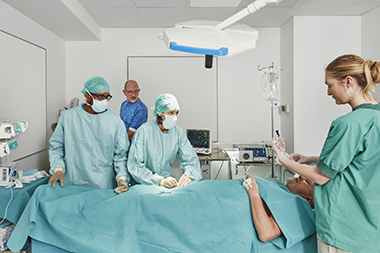
Good acoustics reduce mistakes
In operating rooms, communication and concentration are vitally important. In a study done at Hvidovre Hospital in Copenhagen, Denmark, two operating rooms were given different acoustic treatments.


Over hundreds of thousands of years, our ears have evolved to provide perfect hearing outdoors, in nature. But today most of us spend up to 90% of our time indoors, in environments not suitable for the human ear. This has long-term effects for both patients and staff in healthcare facilities.
Research shows that high sound levels in hospitals and healthcare facilities:
Hospitals are often places where ceilings, walls and floors all have hard and reflective surfaces. When it comes to sound, this means there is nothing to absorb it. It will bounce around and spread everywhere it can, raising noise levels and making it hard to relax and to have normal conversations.
It doesn’t have to be this way. There are solutions – acoustic solutions for ceilings and walls that comply with the hygiene demands in every kind of hospital environment, from intensive care units and operation rooms to patient rooms and airtight laboratories.
This means patients and staff no longer need to cope with poor environments. Instead, we can safely bring the outdoor sound environment indoors, to increase wellbeing, performance, rest and recovery.
Enabling communication is vital in operation rooms
 In specialist care areas, doctors and nurses have to communicate continuously in order to ensure that everybody is informed about what is happening and what is to come. It is crucial that decisions can be made quickly and that everybody is clearly informed about them.
In specialist care areas, doctors and nurses have to communicate continuously in order to ensure that everybody is informed about what is happening and what is to come. It is crucial that decisions can be made quickly and that everybody is clearly informed about them.
When an acoustic solution is introduced, the change will be very noticeable. Stress levels will drop, staff will be able to communicate clearly without raising their voices and patients will have a much better chance of remaining calm.
 Rest and sleep are important aspects of our health and everyday life, but never as important as when we are ill or have undergone surgery and need to heal. When patients suffer from sleep disturbances they will often experience changes in alertness, healing time and length of stay.
Rest and sleep are important aspects of our health and everyday life, but never as important as when we are ill or have undergone surgery and need to heal. When patients suffer from sleep disturbances they will often experience changes in alertness, healing time and length of stay.
Adding sound-absorbing solutions to the ceilings and walls will solve the problems. It will stop sound closer to the source. This lowers sound levels and makes confidential conversations possible even in shared patient rooms. Most important, it improves patients’ ability to sleep soundly.
 Care doesn’t just take place in hospitals. Outpatient clinics and health clinics offer a wide range of treatment services, diagnostic tests and surgical procedures. Patients are just as stressed when they enter one of these facilities as when they go into hospital. Doctors and nurses have the same need for an environment where they can communicate clearly and in private.
Care doesn’t just take place in hospitals. Outpatient clinics and health clinics offer a wide range of treatment services, diagnostic tests and surgical procedures. Patients are just as stressed when they enter one of these facilities as when they go into hospital. Doctors and nurses have the same need for an environment where they can communicate clearly and in private.
With age, our hearing capacity is gradually reduced. This makes us even more sensitive to noise and disturbing sound. If you live in an elderly care unit, you need the environment to be adapted to your perception abilities and the elderly ear, so you can fully enjoy others’ company and actively participate in conversations.
 Up to 40% of hospital premises can consist of office environments. These offices may be used for administration, hospital management or nurses and doctors in wards. A wide range of activities are included in office work. At any given time, people may be talking on the phone, working in teams, holding meetings or performing tasks at the computer that require concentration.
Up to 40% of hospital premises can consist of office environments. These offices may be used for administration, hospital management or nurses and doctors in wards. A wide range of activities are included in office work. At any given time, people may be talking on the phone, working in teams, holding meetings or performing tasks at the computer that require concentration.
Corridors are busy and vibrant areas in healthcare settings. They are everywhere and a natural part of every unit and ward. Patients, visitors and staff use them to move from one place to another. They are also used for moving beds, medical equipment and other supplies.
The solution is to stop sound close to the source, before it spreads, by adding sound-absorbing ceilings and walls. When this is achieved, and people are no longer disturbed by high-level background noise, they will naturally lower their own voices, resulting in reduced sound levels and improving speach clarity.
Download our magazine "Ecophon Healthcare"
Read more in-depth information in any of the following healthcare research studies below, to learn even more about the impact of a good sound environment in hospitals and healthcare facilities.
If you like to know more about our acoustic solutions that meets the hygiene demands for your healthcare facility and at the same time enables a good sound environment, visit our Ecophon Hygiene™ family to learn more.
If you want help, guidance or inspiration to support the creation of a good sound environment , please meet our acoustic experts.

In operating rooms, communication and concentration are vitally important. In a study done at Hvidovre Hospital in Copenhagen, Denmark, two operating rooms were given different acoustic treatments.

At Huddinge University Hospital, Sweden, the physical environment in the intensive coronary heart unit was changed. Researchers investigated the effects of good and bad sound environments regarding patients suffering from chest pain at an intensive coronary heart unit.

In a study of chest pain patients at the intensive coronary heart unit, researchers found that a good sound environment reduces hospital readmissions by having a good sound environment.